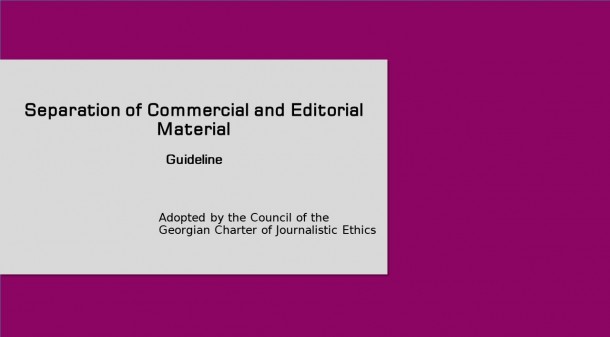In case of incorrect information being published, the editorial group has a challenge to share the corrected information with the same audience who got the incorrect information in the first place. The correction can take different forms, according to the way the information was shared, the scale of the audience and the length that it was available.
1. Main
Principles
- Journalists and editors have to take responsibility for their mistakes and correct them.
- Audience has to understand what was corrected and what was false and is true.
- If the events are ongoing and new details will be revealed, it is necessary to say that the information is renewed.
- The responsibility for the mistake has to be shared between the journalist and editorial group and if possible, the reason should be explained.
- The correction has to be made in the reasonable time. The time is dependent upon the type of the media and scale of the audience, therefore is individual, according to the context.
- Editorial group needs to be attentive to the comments made on different platforms by the audience, which shows the mistake.
- According to the practices of the Charter of Journalistic Ethics, the message about the mistake can be made in any form to the journalist or the editorial group. It will be considered a violation of the correction rule if it becomes known that they knew after publishing the information that it was not true but did not correct it.
- The editorial group has to decide how to react, when to correct/not correct the material, who has to make a decision, etc. after acknowledging that there was a mistake made. It is preferential that organizations have their own guidelines of this procedure.
- It is better if the company’s official web-page has special part where audience can send the information about mistakes.
2. Online
Media
2.1. Correction
- The published information should be corrected in a way that notifies the audience of the correction. Where it is possible and does not damage anybody, it should be noted what was incorrect in the first place.
- When changing the headline, the media should check that it is corrected on every platform where it was shared. Pay attention to the URL of the link, which in many cases is similar to the headline and correct it too.
- In case of correcting the photo, make sure that it is not searchable on any platform of the media.
- Use Facebook tools to correct the link, for the incorrect link not to be shareable anymore.

You can also renew the shared material on Facebook without deleting it.

2.2. Deletion
- Fully deleting the material is the last resort. It can be done when there is no public interest present and it violates somebody’s rights or ethical standards.
- Material can be deleted instead of correcting it when you are the only open source of the information. If others also shared the information, it is better to correct it.
- It is preferable for the media to explain the reason of such decision.
- If in the following days new details are revealed which change the previously shared information, it is better to create a new material and make a link in the previous one about the newer version having been published. (სურათი)
3. Broadcasting
Media
- The broadcaster has to openly and immediately state that a mistake was made and correct it in an equal form. For example, if the mistake was made in prime time in the main news show, it has to be corrected in the same show next day. The equal form of correction depends on the case relevancy and in some cases it might be better to correct the mistake in the next news show.
- Official web-page can be used to correct the information promptly.
- In case of internet broadcasted video, it has to be re-uploaded with the correction on the official webpage and corrected on every platform according to the rules stated in the guidelines for online media.
- According to the code of broadcasters, a person, who was the target of incorrect information, can address the media in 10 days after the broadcasting and request for the mistake to be corrected in equal form or for the information to be denied in the same length and approximately the same manner of the incorrect statement.
4. Printed
Media
- In case of press the equal form and measure are also important. If the incorrect information was printed on the first page of the newspaper, it is preferable for the correction to also be printed on the first page of the next issue. It has to be made clear that information in the previous issue was incorrect.
- The standard of correction for printed media is the same as the online media.
- If the mistake is grave, the editorial group can neglect to wait for the next issue and correct the mistake on their official webpage or social network pages.






